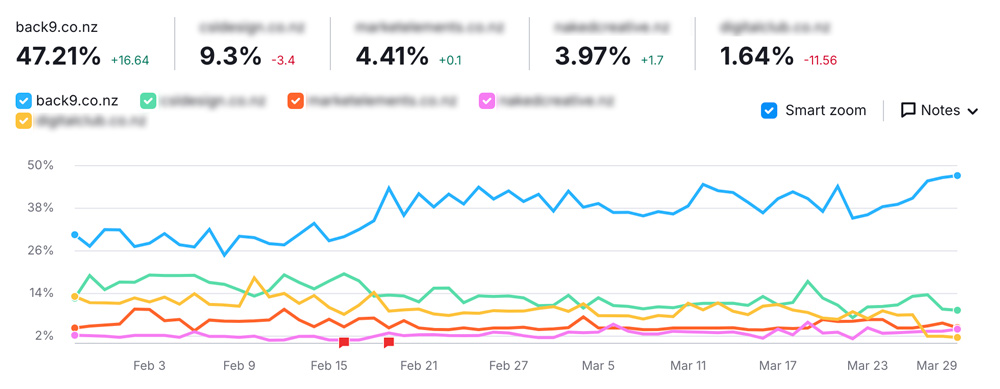Measuring Digital Success in Growth Driven Design Projects

Filters
Results
Growth Driven Website Design (GDD) is transforming the way we approach web design at Back9 Creative. It’s a smarter, agile methodology that minimises risks and drives optimal growth.
But how do you measure digital success in GDD projects?
This is a question that many clients we talk to about Growth-Driven Design grapple with. This is primarily duet to GDD being a highly iterative process. It is fluid and involves continuous learning and improvement. And that’s something that many business owners are not familiar with. Traditionally, when you get something designed is conceptualised, approved and one and done. This is not the case with the Growth Driven Methodology.
In this article, we’ll look at key performance indicators (KPIs) relevant to GDD. Addiiotnally we’ll touch on the role of user data and feedback. And of course the importance of regular analysis and reporting.
By the end, you’ll hopefully have a clear understanding of how to measure and communicate the success of your GDD projects. Let’s get started.
Understanding Growth Driven Design (GDD)
Growth Driven Design (GDD) offers a revolutionary approach to web design. Unlike traditional methods, it focuses on agility and continual growth. GDD prioritizes user experience and data-driven decisions over assumptions.
This method involves launching a “launch pad” website. This site is functional and allows for iterative improvements over time. By constantly analyzing user behavior, GDD ensures that updates are based on concrete data, enhancing the site’s effectiveness. This way, GDD reduces risk and optimizes results, catering to real user needs.
The Iterative Process of GDD
The iterative process in GDD revolves around continuous improvement. Rather than a one-time overhaul, GDD makes incremental changes.
These changes rely heavily on feedback and data analysis. This process begins with a set of hypotheses about how improvements will enhance performance. Changes are then tested in cycles called “sprints.” Each sprint helps uncover new insights, leading to further refinements. This agile method ensures sustained growth and relevance over time.
Setting Measurable Goals
Setting clear, measurable goals is vital in Growth Driven Design. This step aligns the entire project towards definite outcomes.
These goals should be specific, quantifiable, and time-bound, such as increasing user engagement by 20% in three months. Measurable goals guide the testing and learning phases, ensuring each sprint moves toward achieving them. By doing so, you can adjust strategies based on tangible results, driving growth efficiently and effectively.
Key Performance Indicators (KPIs) for GDD
In Growth Driven Design (GDD), Key Performance Indicators (KPIs) are essential in measuring success. These metrics offer insights into how well a site performs and identify areas for improvement. By setting KPIs, you can track progress and stay aligned with your goals.
Some critical KPIs in GDD include:
- Traffic: This measures the number of visitors your site attracts.
- User Engagement: How users interact with your site.
- Conversion Rates: The percentage of visitors completing desired actions.
- SEO: Search engine ranking impacts organic traffic.
By regularly reviewing these indicators, your team can make informed decisions. This ensures that your design efforts lead to measurable outcomes and drive growth. Analyzing KPIs not only boosts performance but also improves user satisfaction. This results in a more effective growth strategy over time.
Traffic and User Engagement
Traffic is the lifeblood of any website. In GDD, this KPI is pivotal in tracking visitor numbers. A steady increase in traffic suggests effective design and marketing efforts.
User engagement goes a step further. It measures how users interact with your site. In particular this is where UX/UI design is so important. Metrics such as time spent on page and bounce rates are critical. But what is even more crucial is interpreting why someone may or may not click on a certain button, image or other element. High engagement typically indicates valuable content and a user-friendly interface.
Conversion Rates and Lead Generation
Conversion rates quantify how effectively your site persuades visitors to take action. These actions will vary depending on your goals. However, they can include making a purchase or filling out a form. A high conversion rate is a clear indicator of success. Again, this reiterates the importance even the basics of UX/UI design. A website must be designed to convert because if it sucks, it won’t! It can also be a great opportunity to employ A/B Testing, (as discussed further below) for measuring digital success.
In addition, Lead generation complements this by tracking new prospects. Effective GDD strategies often enhance these metrics. By optimising user pathways (conversion paths), you’ll likely bolster both engagement and conversions, ultimately leading to growth.
SEO and Organic Search Visibility
SEO is a cornerstone of Growth Driven Design. It influences how easily users find your site via search engines. Good SEO practices increase organic search visibility and drive traffic.

Monitoring your search engine rankings provides essential insights. Rankings influence how your content appears to potential visitors. A focus on SEO within GDD ensures your site remains competitive and visible to your target audience. This enhances your overall growth strategy and effectiveness.
Measuring Digital Success by Utilising User Data and Feedback
User data and feedback are invaluable in Growth Driven Design. They offer a window into user behavior and preferences. Analyzing this data helps refine design choices and improve user experience.
Feedback loops allow you to gather insights directly from users. This continuous input helps validate design hypotheses. It also drives the iterative process that is central to GDD.
By leveraging user data, teams can align their efforts with actual user needs. This fosters a more responsive design approach. As a result, your website continuously adapts to better serve its audience, enhancing overall performance.
Analytics Tools and Data-Driven Decisions
Analytics tools are the backbone of data-driven decision-making in GDD. These tools collect and analyze user interaction data. They highlight what works and what needs improvement.
Insights derived from analytics help prioritise design actions. Data-driven decisions ensure that every change contributes to growth. By aligning efforts with data, teams can create more effective, user-centered designs.
User Feedback Loops and A/B Testing
User feedback loops are crucial for collecting qualitative insights. They offer direct user input on what they like or dislike. This real-time feedback guides iterative improvements in design.
A/B testing, on the other hand, quantifies these insights. It compares user responses to different design versions. This testing method validates changes with statistical significance. Together, feedback loops and A/B testing form a powerful duo in refining user experience, driving measurable improvements in GDD projects.
Reporting and Analysis for GDD
Effective reporting is vital for Growth Driven Design projects. It ensures transparency and accountability. Regular analysis helps teams stay aligned with set goals.
It’s essential to evaluate key metrics continually. This allows for real-time adjustments that drive success. Frequent reporting keeps the project trajectory clear and focused.
A structured reporting framework aids in capturing insights efficiently. This framework should highlight successes and pinpoint areas for improvement. Providing such clarity accelerates the growth-driven process.
Regular Analysis and Reporting
Consistency in analysis is key to a successful GDD project. Regularly reviewing performance metrics highlights actionable trends. This proactive stance prevents issues from escalating.
Implementing scheduled reporting cycles ensures timely updates. These cycles should incorporate data from various touchpoints. Regular updates maintain momentum and strategic focus in GDD projects.
Communicating Results to Stakeholders
Clear communication of results builds trust with stakeholders. It ensures everyone involved understands project progress. Tailored reports can effectively convey relevant insights.
Use visuals to simplify complex data when reporting to stakeholders. This makes information accessible and engaging. An informed stakeholder group supports better decision-making and project alignment in GDD.

Overcoming Challenges in Measuring GDD Success
Measuring digital success in Growth Driven Design can be complex. Challenges often arise from setting relevant metrics and obtaining accurate data. Misaligned expectations can also hinder progress.
To tackle these challenges, GDD teams should adopt flexible, data-driven strategies. Regularly revisiting goals ensures continued alignment with business objectives. This approach allows agile adjustments.
Another aspect is integrating diverse feedback from different team members. This encourages a culture of collaboration and insight-sharing. Such an environment fosters effective problem-solving and enhances the likelihood of GDD success.
Balancing Short-Term Wins and Long-Term Goals
Finding the right balance is important in GDD projects. Short-term wins generate immediate value and motivation. However, without strategic foresight, they may lead to shortsighted decisions.
Long-term goals align efforts with broader business objectives. Prioritizing these goals alongside quick wins ensures sustainable growth. This balance secures both immediate and future benefits.
Scaling GDD Practices and Maintaining Innovation
Scaling GDD practices involves adapting processes as projects evolve. As teams grow, maintaining the original innovation spark can be challenging. It’s essential to keep creativity alive while expanding.
Implementing scalable frameworks allows GDD to adapt to larger contexts. Encouraging a culture of continuous improvement and innovation is vital. This ensures that growth is both sustainable and inventive.
Conclusion: The Continuous Improvement Cycle
Growth Driven Design is all about perpetual evolution. It emphasises ongoing refinement and adaptation to market changes. This dynamic approach ensures that digital solutions stay relevant and impactful.
The continuous improvement cycle in GDD allows teams to learn and pivot quickly. It supports the integration of fresh insights, optimising user experiences over time. By focusing on iterative improvements, GDD aligns closely with strategic goals and can also work well within a set budget.
Checklist for Evaluating GDD Project Success
Assessing the success of a GDD project requires careful evaluation. A structured checklist can guide this process, ensuring comprehensive analysis. Here are key points to consider:
- Define clear, measurable objectives.
- Track key performance indicators (KPIs).
- Gather and act on user feedback.
- Ensure regular progress reports.
- Align results with overall business strategy.
This checklist helps in systematically measuring digital success in terms of GDD outcomes, fostering transparency and accountability.





